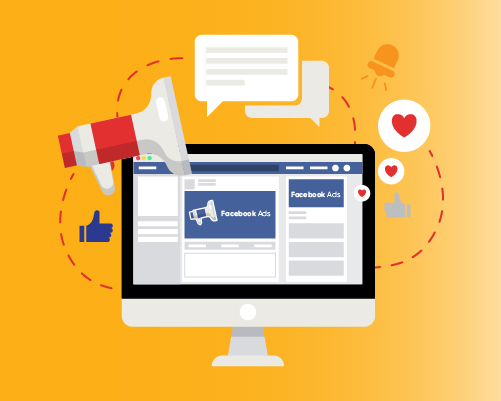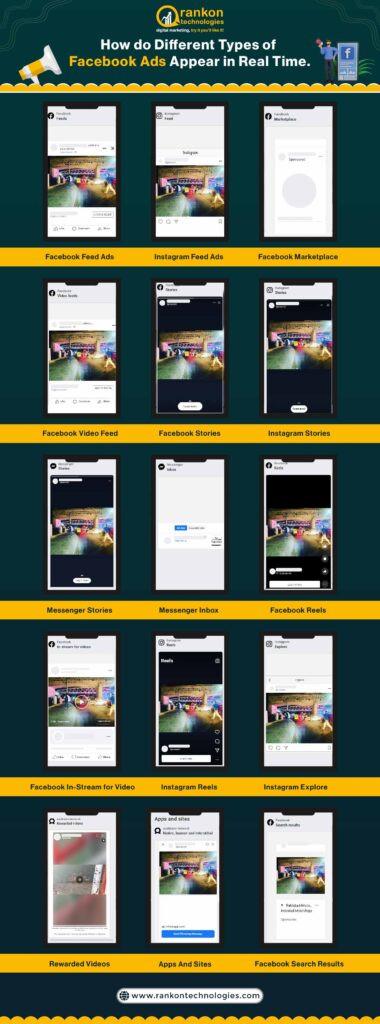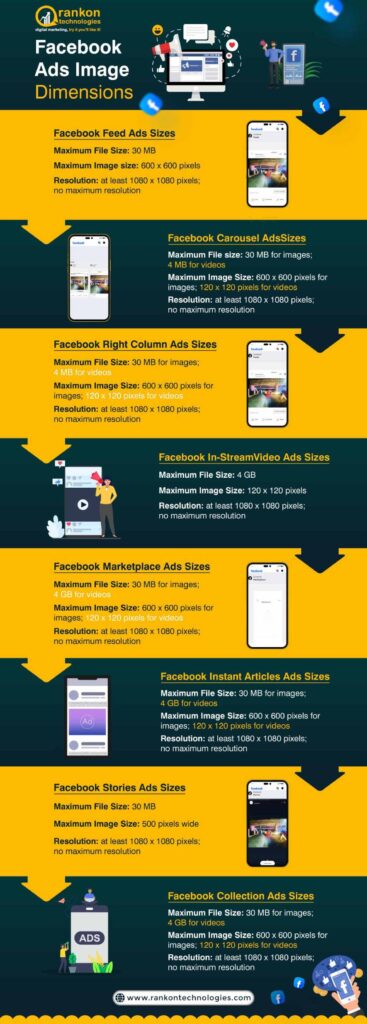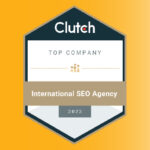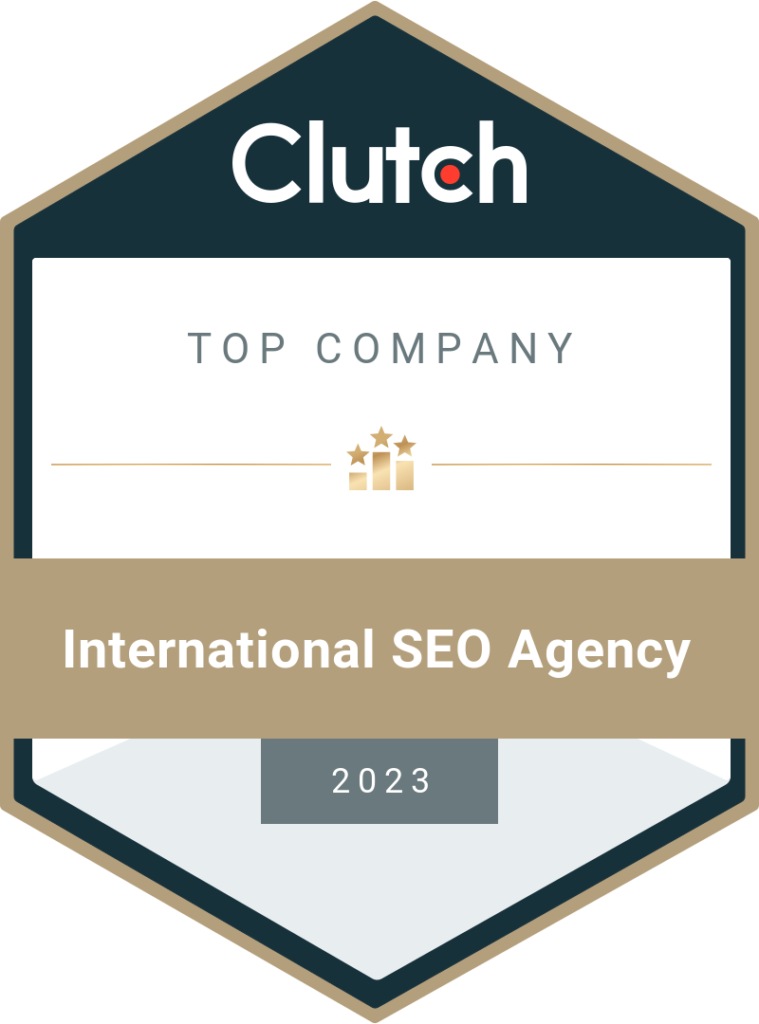With over 2.8 billion monthly active users, Facebook is one of the best advertising platforms for businesses to reach their target audience. However, creating a successful Facebook ad campaign requires more than just posting an image or text on the platform. To get the most out of your advertising budget, it’s important to understand Facebook Ads Objectives and how they can help you achieve your marketing goals.
There are several types of Facebook Ads Objectives that businesses can choose from, depending on their needs and objectives. For example, if your goal is to increase brand awareness and reach a wider audience, you might choose the “Brand Awareness” objective. This type of ad aims to introduce people to your brand by getting as many views as possible.
On the other hand, if you want people to take specific actions such as making purchases or signing up for a newsletter, you might use the “Conversions” objective.
Table of Contents
Type of Facebook Ads Objectives in 2023
Facebook Ads Objectives are essential to any successful Facebook advertising campaign. With over 2.8 billion monthly active users, Facebook has a massive audience and a wide range of ad formats to choose from. The primary goal of Facebook ads objectives is to help advertisers reach their target audience in the most effective way possible.
There are several types of Facebook Ads Objectives available, each designed to meet different advertising goals. These include brand awareness, lead generation, app installs, website conversions, and more.
Let’s understand Facebook Ads Campaign Objectives in detail:
1. Brand Awareness
The Brand Awareness objective is ideal for businesses that want to increase the visibility of their brand. It focuses on getting your brand in front of as many people as possible. This objective is best suited for companies that are new to the market or have just launched a new product or service.
Facebook Brand Awareness Ads Campaign Objective Overview
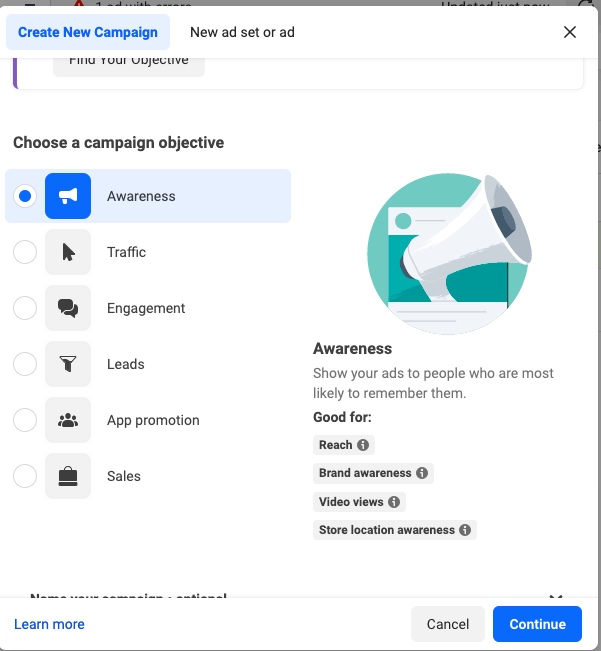
Brand awareness is a crucial objective for any business looking to build a strong presence in the market. It refers to the level of familiarity and recognition that consumers have with a particular brand. The more familiar and recognizable a brand is, the more likely consumers are to trust it and choose it over its competitors.
There are several ways to achieve brand awareness, such as through advertising, social media marketing, content marketing, and public relations. However, it is essential to note that building brand awareness takes time and effort, and it cannot be achieved overnight.
One of the most effective ways to create brand awareness is through consistent messaging and branding across all marketing channels. This means that all communication, from the website to the packaging and advertising, should convey a clear and consistent message about the brand’s values, mission, and unique selling proposition.
Another critical aspect of building brand awareness is understanding the target audience and tailoring messaging to resonate with them. Conducting market research, analyzing consumer behavior, and monitoring social media trends can help businesses better understand their target audience and create messaging that resonates with them.
In conclusion, building brand awareness is a critical objective for any business looking to establish a strong presence in the market. By creating consistent messaging and tailoring it to resonate with the target audience, businesses can create a strong brand image that will attract and retain loyal customers over time.
Who Should Run Brand Awareness Ads on Facebook?
Brand awareness ads are an essential component of any marketing strategy, but the question is, who should run them? The answer is, any business that wants to establish itself as a recognized brand in the market should run brand awareness ads.
Startups and small businesses, in particular, can benefit greatly from brand awareness ads as they are just starting and have yet to establish themselves in the market. These businesses need to get their name out there and let potential customers know about their products or services.
Established businesses can also benefit from Facebook brand awareness ads, as they can help maintain their position in the market and fend off competitors. Even if a business has a strong brand presence, it is essential to continue investing in brand awareness to stay top of mind with consumers.
Another group that can benefit from brand awareness ads is businesses that are launching a new product or service. In this case, brand awareness ads can help generate buzz and excitement about the new offering, making it more likely that consumers will try it out.
In conclusion, any business that wants to establish itself as a recognized brand, maintain its position in the market, or launch a new product or service should run Facebook brand awareness ads. With the right messaging and targeting, these ads can help businesses build a strong brand image and attract and retain loyal customers over time.
Benefits of Facebook Brand Awareness Objective ads
Brand awareness ads are an essential component of any marketing strategy, and they offer several benefits to businesses that invest in them.
Here are some of the benefits of brand awareness ads:
- Increase brand recognition: By running brand awareness ads, businesses can increase their brand recognition, making it more likely that consumers will recognize and remember their brand.
- Build trust and credibility: When consumers are familiar with a brand, they are more likely to trust it and view it as a credible and reliable option.
- Expand customer base: By increasing brand awareness, businesses can attract new customers who may not have been aware of their products or services previously.
- Improve customer loyalty: When customers are familiar with a brand and have had positive experiences with it, they are more likely to become loyal customers and continue to purchase from the brand.
- Stand out from competitors: By building a strong brand image and increasing brand awareness, businesses can differentiate themselves from their competitors and establish themselves as a leader in their industry.
- Increase overall sales: By attracting new customers and building customer loyalty, businesses can increase their overall sales and revenue.
In conclusion, brand awareness ads offer several benefits to businesses, including increasing brand recognition, building trust and credibility, expanding the customer base, improving customer loyalty, standing out from competitors, and increasing overall sales. By investing in brand awareness ads, businesses can establish themselves as a recognized brand and achieve long-term success in the market.
When Should You Run Facebook Brand Awareness Ads?
Running brand awareness ads is an essential component of any marketing strategy, but the question is, when should you run them? Here are some situations where it makes sense to invest in brand awareness ads:
- Launching a new business: If you are starting a new business, it is important to get your name out there and establish yourself as a recognized brand. Running brand awareness ads can help generate awareness and attract potential customers to your new venture.
- Introducing a new product or service: When launching a new product or service, it is important to generate excitement and interest among potential customers. Running brand awareness ads can help create buzz and generate interest in your new offering.
- Entering a new market: If you are expanding your business into a new market, running brand awareness ads can help introduce your brand to a new audience and establish yourself as a player in that market.
- Seasonal peaks: Seasonal peaks, such as the holiday season or back-to-school season, are times when consumer spending increases. Running brand awareness ads during these times can help attract new customers and drive sales.
- When competition is high: If your industry is highly competitive, running brand awareness ads can help differentiate your brand and establish yourself as a leader in the market.
- Building and maintaining brand recognition: Even if your business is established, it is important to continue investing in brand awareness to maintain your position in the market and continue attracting and retaining customers.
In conclusion, running brand awareness ads is important in many situations, including when launching a new business or product, entering a new market, during seasonal peaks, when competition is high, and to maintain brand recognition. By investing in brand awareness ads, businesses can establish themselves as a recognized brand and achieve long-term success in the market.
2. Reach
In the world of Facebook advertising, the objective that you choose can make a big difference in the success of your campaign. One important objective to consider is “Reach”, which is a type of Facebook Ads objective that focuses on getting your ad in front of as many people as possible.
Facebook Reach Ads Campaign Objective Overview
“Reach” is one of the advertising objectives that can be chosen when creating a Facebook or Instagram ad campaign. The primary goal of this objective is to reach as many people as possible within your chosen target audience.
The Reach objective is best used when you want to maximize the number of people who see your ad. This can be useful for businesses that want to increase brand awareness or promote a limited-time offer, event, or sale. It can also be effective for campaigns that aim to drive website traffic or generate leads.
When creating a Reach campaign, you can choose to have your ad shown to people who are most likely to engage with your ad, or to a broad audience. You can also set a frequency cap to limit the number of times each person sees your ad.
One potential drawback of the Reach objective is that it does not guarantee any specific actions, such as clicks or conversions. However, it can be a valuable tool for building brand awareness and getting your message in front of as many people as possible.
Who Should Run Reach Ads on Facebook?
The “Reach” objective on Facebook can be useful for a variety of businesses and marketers, depending on their goals and strategies. Here are a few types of businesses that may benefit from running Reach ads on Facebook:
- Brand Awareness: If you are looking to increase brand awareness, then the Reach objective can be a good fit for your business. By reaching as many people as possible within your target audience, you can make more people aware of your brand and what you have to offer.
- Event Promotion: If you are organizing an event and want to get the word out, the Reach objective can be helpful. You can use it to reach a large number of people in your target audience and let them know about the event details.
- Time-Sensitive Promotions: If you have a limited-time promotion or sale, then the Reach objective can help you get the message out quickly. You can use it to reach as many people as possible in a short period of time.
- New Product Launches: If you are launching a new product and want to generate buzz, the Reach objective can help you reach a large number of people who may be interested in your new offering.
- Local Businesses: If you are a local business and want to reach people in your local area, the Reach objective can be useful. You can target people who live or work within a specific radius of your business location and let them know about your products or services.
Overall, any business or marketer who wants to reach a large number of people quickly and efficiently can benefit from using the Reach objective on Facebook.
Benefits of Facebook Reach ads
The “Reach” objective on Facebook can offer several benefits for businesses and marketers who want to reach a large audience. Here are a few benefits of using Reach ads:
- Increased Brand Awareness: By reaching a large number of people within your target audience, you can increase brand awareness and make more people aware of your business, products or services.
- Cost-Effective: The Reach objective is usually one of the most cost-effective options for running Facebook ads. Since the goal is to reach as many people as possible, the cost per impression can be relatively low compared to other objectives.
- Broad Targeting Options: With the Reach objective, you can choose to target a broad audience or specific demographics, interests, or behaviours. This gives you flexibility in your targeting options to help you reach the right people.
- Increased Reach: The Reach objective can help you reach a large number of people quickly and efficiently. This can be particularly useful if you have time-sensitive promotions or events that you need to promote quickly.
- Frequency Control: You can also set a frequency cap on your Reach ads to ensure that people don’t see your ad too many times. This can help prevent ad fatigue and ensure that your ad remains effective over time.
Overall, the Reach objective can be an effective tool for businesses and marketers who want to reach a large number of people quickly and cost-effectively. By increasing brand awareness and reaching a broad audience, businesses can generate more leads, sales and engagement on Facebook.
When Should You Run Facebook Reach ads?
The “Reach” objective on Facebook can be useful in a variety of situations, depending on your marketing goals and strategies. Here are a few scenarios when you might want to consider running Reach ads:
- Brand Awareness: If you want to increase brand awareness and reach as many people as possible, then the Reach objective can be a good fit. By reaching a broad audience, you can make more people aware of your brand and what you have to offer.
- Limited-Time Offers: If you have a limited-time offer or promotion that you want to promote quickly, then the Reach objective can help you reach as many people as possible in a short period of time.
- Event Promotion: If you are organizing an event and want to get the word out, then the Reach objective can be useful. You can use it to reach a large number of people in your target audience and let them know about the event details.
- New Product Launch: If you are launching a new product and want to generate buzz, then the Reach objective can help you reach a large number of people who may be interested in your new offering.
- Ad Testing: If you are testing different ad creatives or messages and want to see which ones perform best, then the Reach objective can help you reach a large number of people and gather data quickly.
In general, the Reach objective can be effective in situations where you want to reach a large number of people quickly and efficiently. By using this objective, you can increase brand awareness, generate leads, and drive website traffic.
3. Traffic
“Traffic” is a type of Facebook Ads objective that focuses on driving more traffic to your website or landing page. When you select “Traffic” as your objective, Facebook’s algorithm will optimize your ad delivery to show your ad to people who are more likely to click through to your website or landing page. Learn more about Facebook Traffic Ads.
Facebook Traffic Ads Campaign Objective Overview
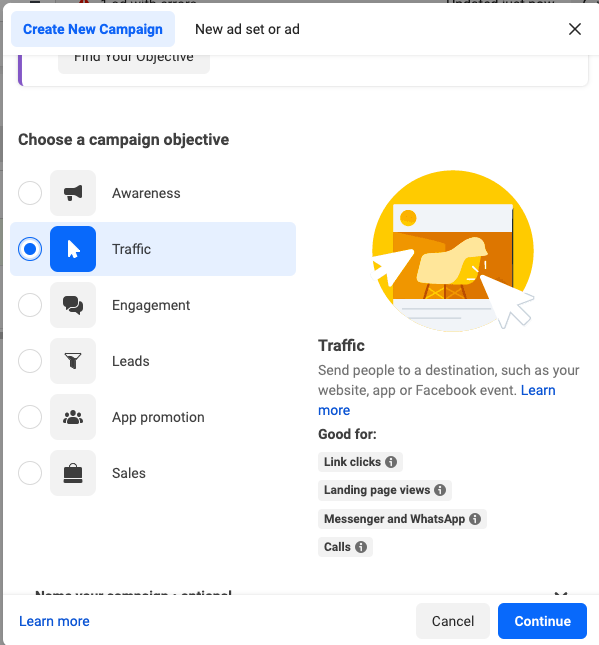
Traffic ads are a type of online advertising that aims to drive more traffic to a website or a specific web page. The objective of traffic ads is to increase the number of visits to a website or a landing page by attracting users who are interested in the product, service, or content being advertised.
Traffic ads are commonly used by businesses that want to increase their online visibility, improve their search engine rankings, or promote a new product or service. These ads can be displayed on a variety of online platforms, including search engines, social media sites, and display networks.
To create an effective traffic ad campaign, advertisers typically need to define their target audience, choose the right keywords, create compelling ad copy and design, and select the most relevant platforms to display their ads. They also need to set a budget and monitor their campaign’s performance regularly to ensure that they are getting a good return on investment.
The success of a traffic ad campaign is usually measured in terms of the number of clicks, impressions, and conversions it generates. By tracking these metrics, advertisers can determine whether their campaign is effective and adjust their strategy as needed to achieve their objectives.
Who Should Run Traffic Ads on Facebook?
Businesses that want to increase the number of visits to their website or specific landing pages should consider running traffic ads on Facebook. This type of ad is particularly useful for businesses that have a clear understanding of their target audience and want to drive targeted traffic to their website.
Traffic ads on Facebook can be beneficial for a wide range of businesses, including e-commerce stores, service-based businesses, content publishers, and more. For example, an e-commerce store could run traffic ads to promote a sale or a new product and attract more customers to their website. A service-based business, such as a fitness studio, could run traffic ads to promote a new class or service and drive more leads to their website.
To run successful traffic ads on Facebook, businesses should have a clear understanding of their target audience and their interests. They should also have a well-designed landing page or website that is optimized for conversions, as well as compelling ad copy and visuals that resonate with their target audience.
In summary, any business that wants to increase website traffic and drive more targeted visitors to their website or landing pages can benefit from running traffic ads on Facebook.
Benefits of Facebook Traffic ads
There are several benefits of using traffic ads as part of a digital advertising strategy. Some of these benefits include:
- Increased website traffic: Traffic ads are designed to drive more visitors to a website or specific landing page, which can result in increased website traffic and improved search engine rankings.
- Targeted audience: Traffic ads can be targeted to specific audiences based on demographics, interests, behaviors, and more. This ensures that the right people are seeing the ad and are more likely to be interested in the product or service being advertised.
- Cost-effective: Traffic ads can be a cost-effective way to increase website traffic and generate leads. Advertisers can set a budget for their campaign and only pay for clicks or impressions, which helps to maximize their return on investment.
- Brand awareness: Running traffic ads can help to increase brand awareness by getting the business in front of more people. Even if a user doesn’t click on the ad, they may still remember the brand and consider it in the future.
- Increased conversions: By driving more targeted traffic to a website or landing page, traffic ads can help to increase conversions and generate more leads or sales for the business.
Overall, traffic ads can be a valuable tool for businesses looking to increase website traffic, generate leads, and improve their online visibility.
When Should You Run Traffic ads on Facebook?
Traffic ads are a type of digital advertising that is effective for a variety of marketing goals. Here are some situations in which running traffic ads can be beneficial:
Launching a new website or product: If a business has recently launched a new website or product, running traffic ads can help to drive more visitors to the site or landing page and increase awareness of the new offering.
Promoting a sale or special offer: Traffic ads can be used to promote a sale or special offer, which can entice potential customers to click through to the website and make a purchase.
Increasing website traffic: If a business wants to increase website traffic and improve their search engine rankings, traffic ads can be an effective way to achieve this goal.
Boosting attendance at an event: If a business is hosting an event, traffic ads can be used to promote the event and encourage more people to attend.
Growing a social media following: Traffic ads can be used to drive traffic to a social media profile, such as a Facebook page or Instagram account, which can help to grow the business’s following and increase engagement with potential customers.
In general, traffic ads can be useful in any situation where a business wants to drive more traffic to a website or landing page and increase their online visibility.
4. Engagement
“Engagement” is a type of Facebook Ads objective that focuses on getting people to engage with your ad or content, such as liking, commenting, or sharing. When you select “Engagement” as your objective, Facebook’s algorithm will optimize your ad delivery to show your ad to people who are more likely to engage with your content.
Facebook Engagement Ads Campaign Objective Overview
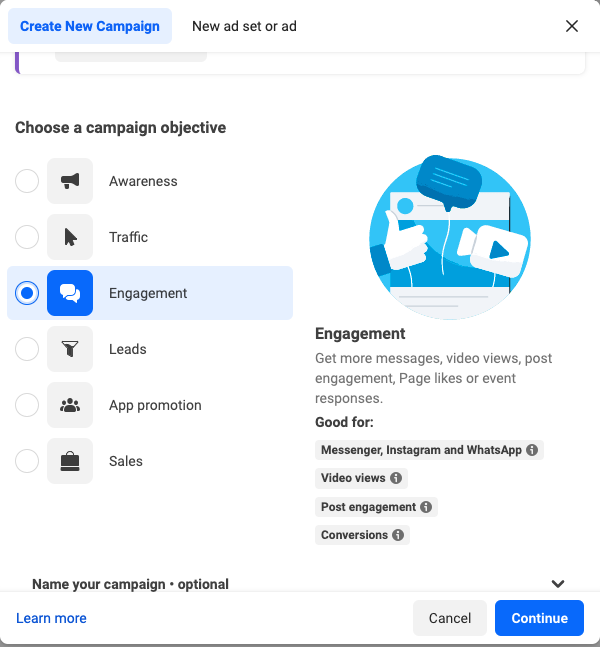
Engagement ads are a type of Facebook advertising objective that aims to increase engagement with a business’s social media content. The objective of Facebook engagement ads is to encourage users to interact with a post, such as liking, commenting, or sharing it, which can increase the post’s reach and visibility on social media.
When creating an engagement ad on Facebook, advertisers can choose from a variety of ad formats, including:
- Image ads: An image ad features a single image and can include a call-to-action (CTA) button.
- Video ads: A video ad features a single video and can include a CTA button.
- Carousel ads: A carousel ad features multiple images or videos that users can swipe through.
- Slideshow ads: A slideshow ad features a looping video made up of multiple images.
- Collection ads: A collection ad features multiple images or videos that users can swipe through, with a CTA button that directs users to a specific product page on the business’s website.
Engagement ads can be targeted to specific audiences based on demographics, interests, behaviors, and more. Advertisers can also choose from a variety of bidding options, including cost per click (CPC) and cost per engagement (CPE), which allows them to optimize their ad campaign for their specific marketing goals.
Overall, the goal of engagement ads is to increase engagement with a business’s social media content, which can help to increase brand awareness, drive more traffic to the business’s website, and ultimately generate more leads and sales.
Who Should Run Engagement Ads on Facebook?
Engagement ads can be beneficial for businesses of all sizes and industries, as they help to increase social media engagement and build a following on Facebook.
Here are some types of businesses that can benefit from running engagement ads:
- Small businesses: Small businesses can use engagement ads to increase brand awareness, build a social media following, and drive more traffic to their website.
- E-commerce businesses: E-commerce businesses can use engagement ads to promote products, increase social media engagement, and drive more traffic to product pages on their website.
- Service-based businesses: Service-based businesses can use engagement ads to increase brand awareness, promote their services, and build a community around their brand.
- Nonprofit organizations: Nonprofit organizations can use engagement ads to increase awareness of their cause, encourage donations, and build a community around their mission.
- Influencers: Influencers can use engagement ads to promote their content, increase their following, and drive more traffic to their website or social media profiles.
In general, any business that wants to increase social media engagement, build a following on Facebook, and improve their overall social media presence can benefit from running engagement ads.
Benefits of Facebook Engagement Ads
Some benefits of using engagement ads include:
- Increased engagement: Engagement ads are specifically designed to encourage users to interact with a post, which can increase the post’s reach and visibility on social media.
- Targeted audience: Engagement ads can be targeted to specific audiences based on demographics, interests, behaviors, and more. This ensures that the right people are seeing the ad and are more likely to engage with the post.
- Cost-effective: Engagement ads can be a cost-effective way to increase social media engagement and grow a following on Facebook. Advertisers can set a budget for their campaign and only pay for clicks or engagements, which helps to maximize their return on investment.
- Brand awareness: Running engagement ads can help to increase brand awareness by getting the business in front of more people and encouraging them to interact with the content.
- Improved social media presence: By increasing engagement and growing a following on social media, engagement ads can help to improve a business’s overall social media presence and increase engagement with potential customers.
When Should You Run Engagement Ads?
Engagement ads can be beneficial in a variety of situations, including:
- Building a social media following: If a business is looking to build a social media following on Facebook, engagement ads can be used to encourage users to like and follow the business’s page.
- Promoting social media content: Engagement ads can be used to promote social media content, such as blog posts, videos, or infographics, which can increase engagement and drive more traffic to the business’s website.
- Encouraging user-generated content: Engagement ads can be used to encourage users to create and share their own content related to the business, which can help to build a community around the brand and increase engagement on social media.
In summary, engagement ads can be a valuable tool for businesses looking to increase social media engagement, grow a following on Facebook, and improve their overall social media presence.
5. App Installs
“App Installs” is a type of Facebook Ads objective that focuses on getting more people to install your mobile app. When you select “App Installs” as your objective, Facebook’s algorithm will optimize your ad delivery to show your ad to people who are more likely to Promote your mobile app or download/install your app.
Facebook App Installs Ads Campaign Objective Overview
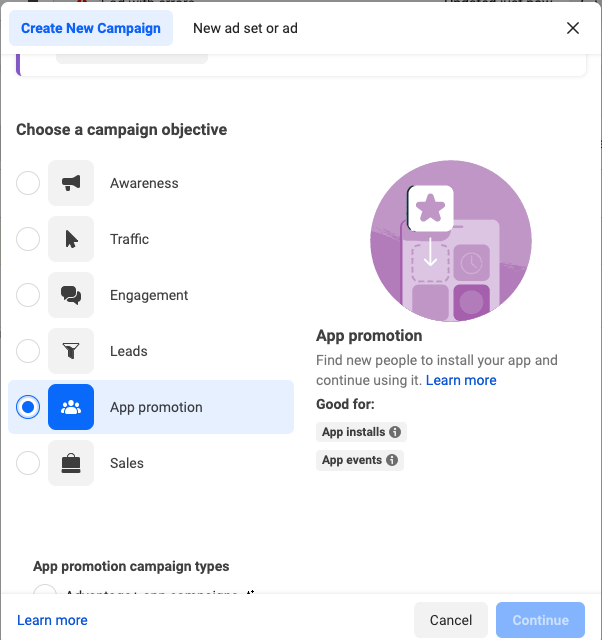
The App Installs Ads objective on Facebook is designed to help businesses and mobile app developers increase the number of downloads and installations of their mobile app on both iOS and Android platforms. This ad format allows advertisers to promote their mobile app to a targeted audience, encouraging them to download and install the app directly from the App Store or Google Play Store.
Also Read: Mobile App Promotion Cost
To create an App Installs Ad on Facebook, advertisers need to choose the objective “App Installs” from the Ads Manager or Business Manager dashboard. Then, they need to select the mobile app they want to promote, set up their ad creative, and define their targeting options.
Facebook offers various targeting options for App Installs Ads, such as location, interests, behaviors, demographics, and device type. Advertisers can also use Facebook’s lookalike audience feature to target users who are similar to their existing app users or website visitors.
App Installs Ads on Facebook can be created using various ad formats, such as single image or video, carousel, or collection. Advertisers can also use App Event Optimization to track specific in-app events, such as purchases or registrations, and optimize their ad delivery towards users who are more likely to perform these events.
Overall, the App Installs Ads objective on Facebook is an effective way for businesses and mobile app developers to increase the visibility and user base of their mobile app, as well as track their advertising performance and ROI.
Who Should Run App Installs Ads on Facebook?
App Installs Ads on Facebook are particularly useful for mobile app developers and businesses that have a mobile app they want to promote and increase their user base. They are suitable for a range of businesses and industries, including gaming, e-commerce, healthcare, finance, and more.
More specifically, App Installs Ads are a good fit for businesses that have recently launched a new mobile app and want to get it in front of their target audience, as well as businesses that want to increase the number of installs and downloads of their existing mobile app. App Installs Ads can also be useful for businesses that have recently updated their mobile app with new features or improvements that they want to promote to their users.
Moreover, App Installs Ads are suitable for businesses that want to reach a specific audience, such as people who have previously installed their mobile app, or people who have shown an interest in similar apps or products. With Facebook’s precise targeting options, businesses can reach the right audience at the right time, increasing the chances of users downloading and installing their app.
Overall, if you have a mobile app you want to promote and increase its user base, App Installs Ads on Facebook can be an effective advertising solution to consider.
Benefits of Facebook App Promotion ads
The benefits of using App Installs Ads on Facebook include:
- Increased app downloads: App Installs Ads are designed to increase the number of downloads and installations of a mobile app on both iOS and Android platforms. These ads are targeted to users who are more likely to download and install the app, based on their interests and behaviors.
- Cost-effective: Facebook’s advertising platform allows businesses to set a budget and bid for app installs, making it a cost-effective way to acquire new users.
- Precise targeting: With Facebook’s precise targeting options, businesses can reach the right audience who are most likely to be interested in their app. Targeting options include location, interests, behaviors, demographics, and device type.
- App Event Optimization: App Event Optimization is a feature that allows businesses to track specific in-app events, such as purchases or registrations, and optimize their ad delivery towards users who are more likely to perform these events.
- Measurable results: With Facebook’s reporting tools, businesses can track the performance of their App Installs Ads and measure the return on investment (ROI) of their advertising spend.
- Customizable ad formats: App Installs Ads can be created using various ad formats, such as a single image or video, carousel, or collection. This allows businesses to create ads that are visually appealing and engaging for their target audience.
- Lookalike audience targeting: Facebook’s lookalike audience feature allows businesses to target users who are similar to their existing app users or website visitors, increasing the chances of acquiring new users who are more likely to engage with their app.
Overall, App Installs Ads on Facebook are a powerful advertising solution for businesses and mobile app developers who want to promote their mobile apps and increase their user base. With precise targeting, customizable ad formats, and measurable results, businesses can effectively acquire new users and track the performance of their ad campaigns.
When Should You Run App Installs ads in Meta?
There are several scenarios in which businesses should consider running App Installs Ads on Facebook:
- Launching a new mobile app: If a business has recently launched a new mobile app, App Installs Ads can be an effective way to promote the app to a targeted audience and increase the number of downloads and installations.
- Updating an existing mobile app: If a business has recently updated their mobile app with new features or improvements, App Installs Ads can help to promote the updated app to existing users and attract new users to download and install it.
- Increasing user base: If a business wants to increase the number of users for their mobile app, App Installs Ads can be an effective advertising solution to acquire new users who are interested in their app.
- Promoting a specific app event: If a business wants to promote a specific in-app event, such as a sale or a new feature, App Installs Ads can help to drive users to the app and encourage them to perform the desired action.
- Re-engaging existing users: If a business wants to re-engage existing users who have previously installed their mobile app but haven’t used it in a while, they can use App Installs Ads to encourage them to return to the app and engage with it.
Overall, businesses should consider running App Installs Ads on Facebook when they want to promote their mobile app, increase its user base, or promote a specific in-app event. With Facebook’s precise targeting options, customizable ad formats, and measurable results, App Installs Ads can be an effective advertising solution for businesses and mobile app developers to acquire new users and track the performance of their ad campaigns.
6. Facebook Video Views Ads Campaign Objective
“Video Views” is a type of Facebook Ads objective that focuses on getting people to watch your video ad. When you select “Video Views” as your objective, Facebook’s algorithm will optimize your ad delivery to show your video ad to people who are more likely to watch it.
Facebook Video Views Ads Campaign Objective Overview
Video Views ads on Facebook are a type of advertising objective that aims to promote video content and increase its views on Facebook and Instagram. With this objective, businesses can create ads that showcase their brand stories, products, or services through engaging video content, and reach a wider audience on the Facebook platform.
When creating Video Views ads, businesses can use various ad formats such as single video, carousel, or collection, and target specific audiences based on demographics, interests, behaviors, and device types. Facebook’s advertising platform allows businesses to set a budget and bid for video views, making it a cost-effective way to promote video content and reach a targeted audience.
The primary goal of Video Views ads is to increase the number of video views, which Facebook counts as any instance where the video is viewed for at least three seconds. The objective is ideal for businesses that want to increase the visibility of their video content, promote their brand awareness, showcase their products or services, or drive user engagement.
When users engage with Video Views ads by watching the videos, businesses can retarget these users with other types of ads, such as lead generation or conversion ads. This approach can help businesses to build brand awareness and drive conversions, leading to increased sales and revenue.
Overall, Video Views ads can be an effective way for businesses to promote their video content on Facebook and Instagram, increase their visibility, and reach a targeted audience. With precise targeting, customizable ad formats, and measurable results, businesses can effectively promote their brand, products, or services through engaging video content and track the performance of their ad campaigns.
Who Should Run Video Views Ads on Facebook?
Video Views ads can be beneficial for businesses and advertisers who want to showcase their products, services, or brand stories through video content. They are particularly useful for businesses that have:
- Engaging video content: If a business has engaging video content that they want to promote and increase the views, Video Views ads can be an effective way to reach a wider audience.
- Brand awareness goals: If a business wants to increase their brand awareness through video content, Video Views ads can help to promote the brand story, message, and values to a targeted audience.
- Product or service demonstrations: If a business wants to showcase their products or services through video demonstrations, Video Views ads can help to attract potential customers and drive sales.
- Events or promotions: If a business has upcoming events or promotions that they want to promote through video content, Video Views ads can help to increase the visibility and reach of these events.
Benefits of Facebook Video Views Ads
Increased visibility: Video Views ads can help to increase the visibility of a business’s video content on Facebook and Instagram, reaching a wider audience and increasing the likelihood of users engaging with the video.
- Cost-effective: Facebook’s advertising platform allows businesses to set a budget and bid for video views, making it a cost-effective way to promote video content and reach a targeted audience.
- Precise targeting: With Facebook’s precise targeting options, businesses can reach the right audience who are most likely to be interested in their video content. Targeting options include location, interests, behaviors, demographics, and device type.
- Customizable ad formats: Video Views ads can be created using various ad formats, such as single video, carousel, or collection. This allows businesses to create ads that are visually appealing and engaging for their target audience.
- Measurable results: With Facebook’s reporting tools, businesses can track the performance of their Video Views ads and measure the return on investment (ROI) of their advertising spend.
When Should You Run Video Views Ads in Meta?
Businesses should consider running Video Views ads on Facebook when they want to promote their video content, increase its visibility, and reach a targeted audience. Video Views ads can be effective for promoting brand awareness, showcasing products or services, promoting events or promotions, and more. With precise targeting, customizable ad formats, and measurable results, businesses can effectively promote their video content and track the performance of their ad campaigns.
7. Lead Generation
“Lead Generation” is a type of Facebook Ads objective that focuses on collecting leads from your target audience. When you select “Lead Generation” as your objective, Facebook’s algorithm will optimize your ad delivery to show your ad to people who are more likely to provide their contact information in exchange for an offer, such as an e-book or webinar.
Lead Generation Ads Campaign Objective Overview
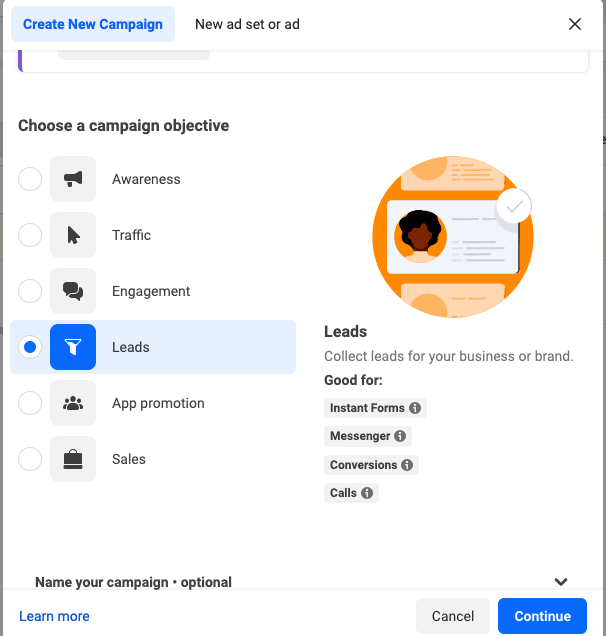
Lead Generation ads on Facebook are a type of advertising objective that aims to collect information from potential customers in exchange for valuable content or incentives. With this objective, businesses can create ads that promote their content or incentives and collect leads directly on Facebook without the need for users to leave the platform.
Lead Generation ads use customizable lead forms that allow businesses to collect specific information from potential customers, such as names, email addresses, phone numbers, job titles, and more. These lead forms can be designed to match the look and feel of the ad, making it easier for users to submit their information.
When creating Lead Generation ads, businesses can use various ad formats such as single image, carousel, or video, and target specific audiences based on demographics, interests, behaviors, and device types. Facebook’s advertising platform allows businesses to set a budget and bid for leads, making it a cost-effective way to collect valuable customer information.
The primary goal of Lead Generation ads is to collect user information and generate leads for businesses. Once businesses have collected leads, they can use this information to nurture these leads through the sales funnel and eventually convert them into customers. Businesses can also integrate Facebook’s lead generation forms with various customer relationship management (CRM) tools, such as MailChimp, HubSpot, and Salesforce, making it easier to manage and nurture their leads.
Lead Generation ads can be beneficial for businesses that have valuable content or incentives, long sales cycles, or email marketing goals. They can be a cost-effective way to collect valuable customer information, target a specific audience, and generate leads for their sales funnel. With customizable lead forms, precise targeting, and integration with CRM tools, businesses can effectively collect leads and nurture them through the sales funnel.
Who Should Run Lead Generation Ads on Facebook?
Lead Generation ads can be beneficial for businesses and advertisers who want to collect user information and generate leads for their sales funnel. They are particularly useful for businesses that have:
Valuable content or incentives: If a business has valuable content or incentives, such as e-books, webinars, free trials, or discounts, that they want to offer to potential customers in exchange for their contact information, Lead Generation ads can be an effective way to collect these leads.
- Long sales cycles: If a business has a long sales cycle and needs to nurture potential leads through the sales funnel, Lead Generation ads can help to collect information from these leads and start the nurturing process.
- Email marketing goals: If a business has email marketing goals, such as increasing their email list, Lead Generation ads can help to collect leads and build a list of potential customers for email marketing campaigns.
Benefits of Lead Generation Ads on Facebook
- Cost-effective: Lead Generation ads can be a cost-effective way to generate leads for businesses, as they only pay for the leads collected, rather than clicks or impressions.
- Precise targeting: With Facebook’s precise targeting options, businesses can reach the right audience who are most likely to be interested in their content or incentives. Targeting options include location, interests, behaviors, demographics, and device type.
- Customizable lead forms: Lead Generation ads allow businesses to create customizable lead forms that collect specific information from potential customers, such as name, email address, phone number, job title, and more.
- Automated lead capture: Facebook’s lead generation forms can automatically capture leads’ contact information, making it easy for businesses to collect and download the leads’ information for further use.
Integration with CRM tools: Facebook’s lead generation forms can be integrated with various customer relationship management (CRM) tools, such as MailChimp, HubSpot, and Salesforce, making it easy for businesses to manage and nurture their leads.
When Should You Run Lead Generation Ads on Facebook?
Businesses should consider running Lead Generation ads on Facebook when they want to collect user information, generate leads, and build their email list. Lead Generation ads can be effective for businesses that have valuable content or incentives, long sales cycles, or email marketing goals. With precise targeting, customizable lead forms, automated lead capture, and integration with CRM tools, businesses can effectively collect leads and nurture them through the sales funnel.
8. Messages
“Messages” is a type of Facebook Ads objective that focuses on encouraging people to start a conversation with your business through Facebook Messenger. When you select “Messages” as your objective, Facebook’s algorithm will optimize your ad delivery to show your ad to people who are more likely to send a message to your business.
Facebook Messages Ads Campaign Objective Overview
Messages ads on Facebook are a type of advertising objective that aims to initiate conversations with potential customers through the Messenger app. With this objective, businesses can create ads that encourage users to start a conversation with the business on Messenger, where they can provide personalized customer support and guidance.
Messages ads can be created using various ad formats, such as single image, carousel, or video, and businesses can target specific audiences based on demographics, interests, behaviors, and device types. Facebook’s advertising platform allows businesses to set a budget and bid for ad placement, making it a cost-effective way to start conversations with potential customers.
When creating Messages ads, businesses can use various call-to-action buttons, such as “Send Message” or “Get Started,” to encourage users to start a conversation. Once a user starts a conversation, businesses can provide personalized support, answer questions, and guide potential customers through the sales funnel. Businesses can also use Facebook’s Messenger platform to set up automated responses to common questions, making it easier to provide quick responses and assistance to potential customers.
The primary goal of Messages ads is to initiate conversations with potential customers and provide personalized customer support and guidance. By providing personalized support and guidance, businesses can build trust with potential customers and increase the likelihood of converting them into customers. Businesses can also use Messenger to send follow-up messages and nurture relationships with potential customers.
Messages ads can be beneficial for businesses that have customer support needs, high-value products or services, or personalized sales experiences. They can be a cost-effective way to start conversations with potential customers, provide personalized support, and guide potential customers through the sales funnel. With various call-to-action buttons, automated responses, and follow-up messages, businesses can effectively initiate conversations with potential customers and build relationships with them.
Who Should Run Messages Ads on Facebook?
Messages ads can be beneficial for businesses and advertisers who want to engage in one-on-one conversations with potential customers and provide personalized customer support. They are particularly useful for businesses that have:
- Customer support needs: If a business has customer support needs and wants to provide immediate assistance to potential customers, Messages ads can be an effective way to start a conversation and provide personalized support.
- High-value products or services: If a business has high-value products or services, Messages ads can be a great way to provide more information and answer potential customers’ questions directly.
- Personalized sales experiences: If a business wants to provide a personalized sales experience and guide potential customers through the sales funnel, Messages ads can be an effective way to start a conversation and build a relationship with potential customers.
Benefits of Facebook Messages Ads
- Increased engagement: Messages ads can increase engagement by providing a one-on-one conversation between the business and potential customer, making it more likely that the potential customer will take action.
- Personalized support: Messages ads can provide personalized customer support, making it easier for businesses to address customer questions and concerns.
- Automated responses: Facebook’s Messenger platform allows businesses to set up automated responses to common questions, making it easier to provide quick responses and assistance to potential customers.
- Improved customer experience: Messages ads can provide a better customer experience by allowing businesses to provide immediate support and guidance to potential customers.
- Higher conversion rates: Messages ads can lead to higher conversion rates by providing personalized sales experiences and guiding potential customers through the sales funnel.
When Should You Run Messages Ads on Facebook?
Businesses should consider running Messages ads on Facebook when they want to engage in one-on-one conversations with potential customers, provide personalized support, or provide a personalized sales experience. Messages ads can be effective for businesses that have high-value products or services or customer support needs. With increased engagement, personalized support, automated responses, improved customer experience, and higher conversion rates, Messages ads can be an effective way to build relationships with potential customers and guide them through the sales funnel.
9. Conversions
“Conversions” is a type of Facebook Ads objective that focuses on driving specific actions on your website or app, such as making a purchase, filling out a form, or subscribing to a newsletter. When you select “Conversions” as your objective, Facebook’s algorithm will optimize your ad delivery to show your ad to people who are more likely to take the desired action on your website or app.
Facebook Conversions ads Campaign Objective Overview
Conversions ads on Facebook are a type of advertising objective that aims to drive specific actions on a business’s website or app, such as making a purchase, filling out a form, or signing up for a service. With Conversions ads, businesses can create ads that target users who are most likely to take the desired action, and direct them to optimized landing pages that are designed to encourage the action.
When creating Conversions ads, businesses can use various ad formats, such as single image, carousel, or video, and target specific audiences based on demographics, interests, behaviors, and device types. Facebook’s advertising platform allows businesses to set a budget and bid for ad placement, ensuring that they only pay for ad placements that result in the desired action.
To track and optimize Conversions ads, businesses can use Facebook’s pixel, a piece of code that can be added to a website or app to track user actions and provide insights into ad performance. The pixel can be used to track a range of actions, such as purchases, sign-ups, or form submissions, and can provide insights into the effectiveness of ad campaigns and help businesses optimize their targeting and ad creative.
The primary goal of Conversions ads is to drive specific actions on a business’s website or app and increase revenue. By targeting users who are most likely to take the desired action and directing them to optimized landing pages, businesses can increase the likelihood of converting users into customers. With Facebook’s pixel, businesses can track and optimize ad campaigns, ensuring that they are reaching the right audience and driving the desired actions.
Conversions ads can be beneficial for businesses that want to drive specific actions on their website or app, such as e-commerce websites, lead generation needs, or mobile apps. By improving targeting, increasing website or app traffic, increasing conversion rates, and being cost-effective, Conversions ads can be an effective way to drive specific actions and increase revenue.
Who Should Run Conversions Ads on Facebook?
Conversions ads can be beneficial for businesses that want to drive specific actions on their website or app.
They are particularly useful for businesses that have:
- E-commerce websites: If a business has an e-commerce website, Conversions ads can be an effective way to drive purchases and increase revenue.
- Lead generation needs: If a business wants to generate leads or collect customer information, Conversions ads can be an effective way to drive form submissions or sign-ups.
- Mobile apps: If a business has a mobile app, Conversions ads can be an effective way to drive app installs and in-app actions, such as purchases or sign-ups.
Benefits of Facebook Conversions Ads
- Improved targeting: Conversions ads allow businesses to target specific audiences based on their behavior, interests, demographics, and device types, making it more likely that the ad will reach potential customers who are likely to take the desired action.
- Increased website or app traffic: Conversions ads can increase website or app traffic by directing users to specific landing pages that are optimized for the desired action.
- Higher conversion rates: Conversions ads can lead to higher conversion rates by targeting users who are most likely to take the desired action and directing them to optimized landing pages.
- Cost-effective: Conversions ads can be a cost-effective way to drive specific actions, as businesses can set a budget and bid for ad placement, ensuring that they only pay for ad placements that result in the desired action.
When Should You Run Conversions Ads on Facebook?
Businesses should consider running Conversions ads on Facebook when they want to drive specific actions on their website or app, such as purchases, form submissions, or sign-ups. Conversions ads can be effective for businesses that have e-commerce websites, lead generation needs, or mobile apps. With improved targeting, increased website or app traffic, higher conversion rates, and cost-effectiveness, Conversions ads can be an effective way to drive specific actions and increase revenue.
10. Catalog Sales
“Catalog Sales” is a type of Facebook Ads objective that focuses on promoting products from your e-commerce catalog and driving sales on your website or app. When you select “Catalog Sales” as your objective, Facebook’s algorithm will optimize your ad delivery to show your ads to people who are more likely to make a purchase.
Facebook Catalog Sales ads Campaign Objective Overview
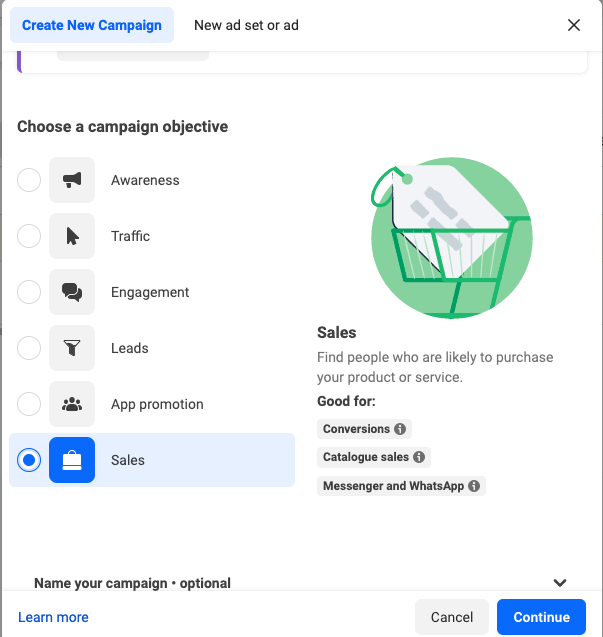
Catalog Sales ads on Facebook are a type of advertising objective that aims to promote a business’s product catalog and drive sales. With Catalog Sales ads, businesses can showcase their products to users who are most likely to be interested in them and drive them to make a purchase.
To use Catalog Sales ads, businesses need to create a product catalog on Facebook or upload their catalog from an e-commerce platform. Once the catalog is set up, businesses can use Facebook’s dynamic ads feature to automatically show the most relevant products to users, based on their interests and browsing behavior.
When creating Catalog Sales ads, businesses can use various ad formats, such as single image, carousel, or collection ads, and target specific audiences based on demographics, interests, behaviors, and device types. Facebook’s advertising platform allows businesses to set a budget and bid for ad placement, ensuring that they only pay for ad placements that result in sales.
The primary goal of Catalog Sales ads is to drive sales and increase revenue by showcasing relevant products to users who are most likely to make a purchase. By using dynamic ads to showcase products from the business’s catalog, Catalog Sales ads can increase engagement and conversion rates, ultimately driving more sales and revenue.
Catalog Sales ads can be beneficial for businesses that sell products online and have a large product catalog, such as e-commerce websites, online retailers, or businesses with a wide range of products. By using dynamic ads to showcase products to interested users, Catalog Sales ads can help businesses increase engagement, conversion rates, and ultimately drive more sales and revenue. Catalog Sales ads are also beneficial for businesses that want to automate their advertising and save time and resources on ad creation and targeting.
Who Should Run Catalog Sales Ads on Facebook?
Catalog Sales ads on Facebook are ideal for businesses that sell products online and have a large product catalog. This includes e-commerce websites, online retailers, and businesses with a wide range of products.
If your business wants to showcase its products to users who are most likely to be interested in them and drive them to make a purchase, then Catalog Sales ads may be a good fit. By using dynamic ads to showcase products from your catalog, Catalog Sales ads can help increase engagement and conversion rates, ultimately driving more sales and revenue.
In addition, if your business wants to automate its advertising and save time and resources on ad creation and targeting, then Catalog Sales ads can be beneficial. By setting up a product catalog on Facebook and using dynamic ads, businesses can automate the advertising process and reach potential customers at scale.
Overall, businesses that want to drive sales and revenue by showcasing their products to interested users and automating their advertising should consider using Catalog Sales ads on Facebook.
Benefits of Facebook Catalog Sales ads
Catalog Sales ads on Facebook have several benefits for businesses that sell products online:
- Increased Product Visibility: Catalog Sales ads allow businesses to showcase their products to a large and targeted audience. With dynamic ads, businesses can automatically show the most relevant products to users, based on their interests and browsing behavior. This increases the visibility of products and can lead to more clicks, engagement, and ultimately, sales.
- Increased Engagement and Conversion Rates: By showing relevant products to interested users, Catalog Sales ads can increase engagement and conversion rates. Users are more likely to click on an ad and make a purchase if they see products that are relevant to their interests and needs. With dynamic ads, businesses can also show multiple products in a single ad, increasing the likelihood that users will find something they want to purchase.
- Automated Advertising: Setting up a product catalog on Facebook and using dynamic ads can help businesses automate their advertising and save time and resources on ad creation and targeting. Once the catalog is set up, businesses can create ads in minutes and reach potential customers at scale.
- Measurable Results: Catalog Sales ads allow businesses to track the performance of their ads and measure their return on investment. By setting up conversion tracking, businesses can see how many purchases were made as a result of their ads and how much revenue was generated.
Overall, Catalog Sales ads can help businesses increase product visibility, engagement, and conversion rates, while also automating their advertising and providing measurable results. By using Catalog Sales ads, businesses can drive more sales and revenue from their product catalog.
When Should You Run Catalog Sales ads?
Businesses should consider running Catalog Sales ads on Facebook when they want to promote their product catalog and drive sales. Here are a few scenarios where running Catalog Sales ads can be effective:
- New Product Launch: When launching a new product or collection, Catalog Sales ads can help increase product visibility and generate sales. By showing ads to users who have expressed interest in similar products, businesses can drive traffic to their website and generate sales from new product launches.
- Seasonal Promotions: During seasonal sales and promotions, Catalog Sales ads can help businesses reach a larger audience and drive more sales. By showcasing products that are relevant to the season or promotion, businesses can increase engagement and conversion rates.
- Retargeting: Retargeting users who have previously viewed products on a website or added items to their cart but did not complete a purchase can be an effective way to drive sales. By using dynamic ads to show the exact products that users viewed or added to their cart, Catalog Sales ads can help businesses bring back lost sales.
- Upselling and Cross-selling: By showing users products that are complementary or similar to what they have already purchased, businesses can increase the average order value and generate more revenue. Catalog Sales ads can help businesses upsell and cross-sell products by showing relevant products to users who have made a purchase in the past.
Overall, businesses should consider running Catalog Sales ads on Facebook when they want to increase product visibility, drive sales, and promote their product catalog to a targeted audience. By using dynamic ads and targeting options, businesses can reach potential customers at scale and generate measurable results.
11. Store Traffic
“Store Traffic” is a type of Facebook Ads objective that focuses on driving foot traffic to your physical store locations. When you select “Store Traffic” as your objective, Facebook’s algorithm will optimize your ad delivery to show your ads to people who are more likely to visit your store in person.
Facebook Store Traffic ads Campaign Objective Overview
Store Traffic ads objective is a type of Facebook advertising campaign that aims to drive more foot traffic to a physical store or location. This objective is particularly useful for businesses that have a physical presence and want to increase the number of people visiting their stores.
With Store Traffic ads, businesses can create ads that show their store’s location, hours, and other details to potential customers who are nearby or who have expressed interest in similar businesses or products. These ads typically feature a call-to-action button that encourages people to visit the store and can be targeted based on various factors, including location, interests, and demographics.
By using this objective, businesses can reach people who are most likely to visit their store, increase brand awareness, and ultimately drive more sales. It is important to note that in order to use the Store Traffic ads objective, businesses need to have a physical store with a physical address that can be displayed in the ad.
Who Should Run Store Traffic Ads on Facebook?
Store Traffic ads are ideal for brick-and-mortar businesses that want to drive more in-store traffic and sales. Businesses that can benefit from Store Traffic ads include:
- Retailers: Retail stores, such as clothing stores, department stores, and specialty stores, can use Store Traffic ads to drive more foot traffic to their stores and increase sales.
- Restaurants: Restaurants and cafes can use Store Traffic ads to promote new menu items, drive more foot traffic, and increase sales.
- Automotive Dealerships: Automotive dealerships can use Store Traffic ads to promote new car models, drive more potential customers to their dealership, and increase sales.
- Fitness Centers: Fitness centers and gyms can use Store Traffic ads to promote new classes or workout programs, drive more foot traffic to their location, and increase membership sign-ups.
Benefits of Store Traffic Ads
- Drive More Foot Traffic: Store Traffic ads allow businesses to reach a larger audience and promote their physical location, driving more foot traffic and potential customers to their store.
- Local Targeting: Store Traffic ads can be targeted to users within a specific geographic area, allowing businesses to reach potential customers who are more likely to visit their store.
- Measurable Results: By using Facebook’s tracking and reporting tools, businesses can track the performance of their Store Traffic ads and measure their return on investment.
- Cost-Effective: Store Traffic ads are typically less expensive than other advertising options, making them a cost-effective way for businesses to promote their physical location and drive more foot traffic.
When Should You Run Store Traffic Ads?
Businesses should consider running Store Traffic ads on Facebook when they want to promote their physical location, drive more foot traffic, and increase sales.
Here are a few scenarios where running Store Traffic ads can be effective:
- Grand Openings: When opening a new store or location, Store Traffic ads can help businesses promote their grand opening and drive more foot traffic to their location.
- Seasonal Promotions: During seasonal sales and promotions, Store Traffic ads can help businesses reach a larger audience and drive more foot traffic to their store.
- New Product Launches: When launching a new product or collection, Store Traffic ads can help increase foot traffic to the store and generate sales.
- Clearance Sales: When holding a clearance sale or offering discounts on inventory, Store Traffic ads can help businesses drive more foot traffic to their store and increase sales.
Overall, Store Traffic ads can be an effective way for brick-and-mortar businesses to drive more foot traffic, promote their physical location, and increase sales. By targeting local users and using Facebook’s tracking and reporting tools, businesses can measure the impact of their Store Traffic ads and optimize their advertising strategy over time.
Want to learn more about Facebook Ads Campaign Objectives?
In conclusion, choosing the right Facebook Ads objective is crucial for the success of your ad campaign. Each objective serves a specific purpose, and understanding the benefits and best use cases of each objective is important when creating your campaign strategy.
For businesses looking to increase brand awareness and reach a wider audience, objectives such as “Reach” and “Engagement” may be most effective. If your goal is to drive specific actions on your website or app, then objectives such as “Conversions” or “App Installs” may be the best choice. For e-commerce businesses looking to promote their products and drive sales, “Catalog Sales” may be the ideal objective. And for businesses with physical store locations, “Store Traffic” can help drive foot traffic and increase in-store sales.
When choosing a Facebook Ads objective, it’s important to consider your overall campaign goals and the specific actions you want your audience to take. By selecting the right objective for your campaign, you can optimize your ad delivery and maximize your chances of success.
Need More Help with Facebook Ads?
Want to run ads on Facebook? Contact RankON Technologies for best Facebook marketing services at affordable prices. Visit our Facebook marketing plans now!
Get in Touch!Check our Facebook Marketing Packages

